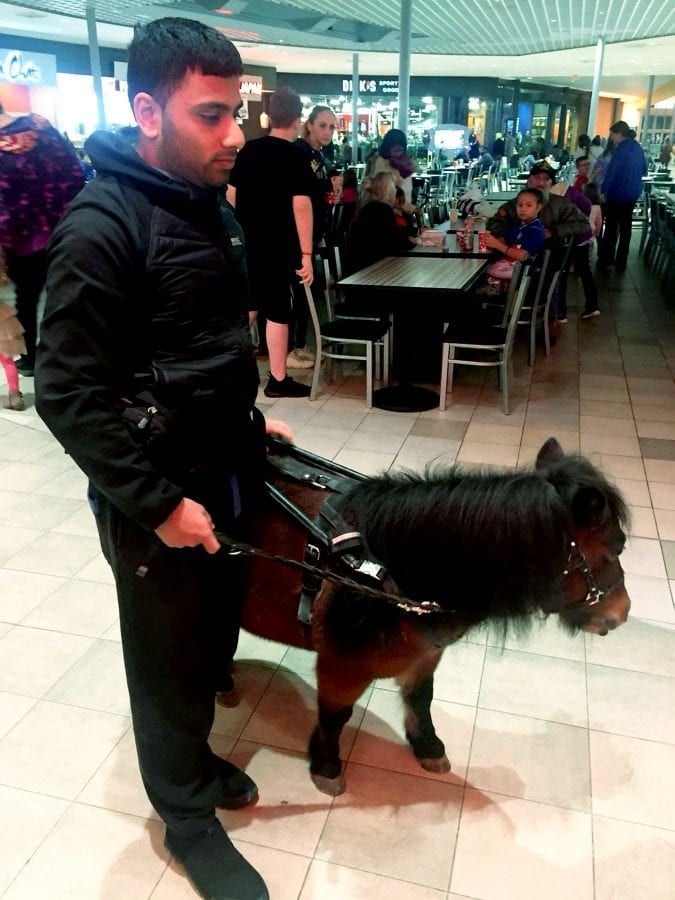
Britain’s first guide HORSE helping a blind man with a fear of dogs has been given the chop – after it unexpectedly grew too BIG.
Mohammed Salim Patel, 24, admits losing his prospective full-time helper Digby is a “kick in the teeth”.
The BBC journalist has degenerative eye condition retinitis pigmentosa which has left him registered blind – but also has a phobia that rules out a guide dog.
He formed a close bond with UK-based American miniature Digby and the double act were pictured strolling through Northallerton, North Yorks., in February this year.
It had been hoped Digby – who initially stood at 29 inches – would become Mohammed’s guide horse following a two-year-long training programme.
However, concerns were raised about Digby’s size after he had an unpredicted growth spurt and grew to 33 inches – three inches taller than the universally accepted size.
But Mohammed has now visited the US to test out guide horses which were 30 inches high or under.
Mohammed, who works as a planning producer on BBC North West Tonight, went to the US last month for ten days to see fully-trained guide horses in action and work with them.
Heartwarming footage shows him being led through the streets of Lansing, Michigan by a guide horse called Cali who is both house and toilet trained.
He said: “It’s not a case of Digby is not suitable for just me, he has sadly grown to 33 inches. As a guide horse he would not have a future fulfilling the role properly because of his size.
“It’s a kick in the teeth, my story was such I never would have thought I would benefit from a service animal.
“I read about guide horses and over time had Digby in mind to be my service horse but then he grew.
“As time went on we were going into supermarkets, offices and it was more of a squeeze. I would be knocking things over on shelves and walking sideways to accommodate both of us and that’s not practical.
“It’s nobody’s fault, that did mean my visions to have Digby by my side long-term are not going to come to fruition anymore.
“If I had not gone to the US it would have been a setback. I don’t see it as a setback, I’m still going to get a guide horse and it’s still going to be the same time frame.
“If it was the case that he was the only candidate it would have been a setback.
“I saw four guide horses while I was in the US, all of them were between 27 and 29 inches. If we would have known this we would not have embarked on this.”
Mohammed, from Blackburn, Lancs., could be left housebound without the help of a service animal. He originally got the idea from a documentary on guide horses in the US.
Digby was being trained by Katy Smith and there were hopes he would eventually be able to unload the washing machine and mop the floor.
Mohammed went out to Lansing, Michigan, and Albany, New York, to work with, walk with and see what a fully-trained guide horse could actually do.
“My trip to America would allow me to see the stature of their horses, and therefore compare Digby to them,” Mohammed said.
“This would then help with making my decision on his suitability.
“Feeling Cali for the first time was breathtaking but it also added to my feelings that Digby would no longer be suitable for me.
“I also met miniature horses Willow, Maya and Panda. Seeing their size cemented my knowledge that a guide horse needs to be within the universally accepted and agreed size of 30 inches high or under.
“I’m gutted that Digby isn’t going to be my guide horse. I had formed a bond with him and saw the amazing potential he had as a guide, due to his temperament.
“Being led by a guide horse allowed me to walk at speeds and with confidence that I’ve never had when being guided by a human or using a cane. It was like I wasn’t blind when I had the harness for Cali in my hand.”
Horses began being used for guiding roles as an experimental programme in the early 2000s in the US.
With an average lifespan of 30 to 40 years they can remain with their owner for much longer than a guide dog.
by Nathan Sandhu